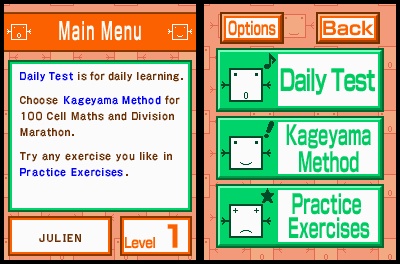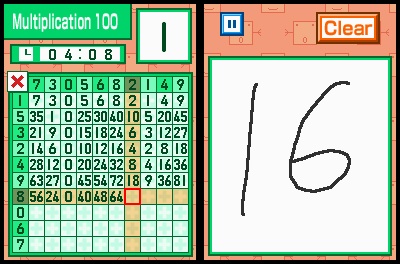Regardless of whether you support or deplore the rapidly expanding appeal of the casual-games market, it looks as if it's here to stay, with Nintendo's Wii console and DS handheld opening new doors and taking us on a monumental evolutionary jump during the past couple of years. Like Brain Age before it, Professor Kageyama's Maths Training: The Hundred Cell Calculation Method will be right up your alley if your idea of a good time is memorizing, counting, and practicing your maths skills. Unfortunately, if you're more of a Professor Layton and the Curious Village kind of fan looking for fun and challenging puzzles, this game will definitely leave you unfulfilled.

Professor Kageyama's Maths Training: The Hundred Cell Calculation Method (which for simplicity's sake we'll simply refer to as Maths Training from here onward) is in no uncertain terms a mathematical revision tool. Its strength does not lie in teaching new skills, but rather reinforcing what you already know, and offering a daily refresher course in the form of a three-part quiz with the aim to sharpen your existing numeric skills. Over time, this in turn is designed to improve your accuracy and speed.
The core gameplay revolves around a daily test designed to help track your progress by offering three quizzes that can be completed in as few as five minutes. The difficulty ramps accordingly, beginning with simple addition, subtraction, and counting flash cards, and moving on to more challenging tests. For example, one test presents you with a sum with a missing number, such as 8 + X=10 (here you have to write down 2 as the missing number). These challenges are a great refresher for anyone who may not do an awful lot of everyday maths without a calculator, but their real-world practicality is somewhat limited because you don't do useful tasks such as converting values to percentages, or determining the compound interest on your pocket money. The game sticks strictly to the fundamentals here. There's also no real fun element to push the player on; the most brightly coloured objects in the game are the flash object cards seen early in the piece for counting. The big hook here is that each challenge can be performed in the free-play practice mode at any time, with each attempt timed, and the top three scores registered on the game's leaderboard on the console. Once you've done the daily challenge, you can pack it away until next time, or try to break either one of your own or someone else's score, provided that your opponent has completed the test on your cartridge. Visual tutorials precede each test, so you won't have anyone but yourself to blame when you have no idea how to answer a question.
Leaving you on your lonesome to do maths puzzles would be downright cruel. Luckily, Maths Training also features a multiplayer component that lets up to 16 players go head-to-head using only a single copy of the game and the DS Download Play feature on each of the handhelds. There's no danger that Maths Training will be replacing your weekly Pokémon battle, though, given that the gameplay is really just an extension of the single-player challenges. That said, it's a reasonable way to break up the repetition of doing practice rounds between daily tests, and a great way to fool kids into doing maths under the cunning guise of entertainment. Seeing as how the game doesn't introduce any new mathematical concepts apart from the Kageyama method (which is essentially just addition, subtraction, or multiplication in a grid layout), there's no unfair advantage for a seasoned veteran playing against a still-green Maths Training virgin, as long as you can use the stylus.

Handwriting recognition has always been the bane of stylus-driven games, which rely heavily on character or number input. Considering that Professor Kageyama's Maths Training isn't exactly bursting with customization features--you can play either left- or right-handed--and no training is required for your individual writing style, the software does quite a good job at recognizing what it is you're trying to write. Unfortunately, certain numbers seem to have a higher failure rate than others, and though the numbers one, seven, and nine are all picked up with a high level of accuracy (probably because of their rudimentary strokes), two often appears in place of three, five occasionally registers as eight, and depending on how you write them, fours can be particularly frustrating when they become either two or nine. There is an autocomplete feature that often lets you input a correct answer before you finish the intended stroke, but this also works against you because the interpretation is sometimes off. The procedure forces you to click the clear button at the top of the screen and wastes precious seconds, which is a big issue for the time-trial-based nature of play. In a game where time is of the essence, dodgy number entry can be the difference between a gold medal and even making it onto the maths podium.
The game's practice mode alone contains 45 different tests that can be played at your leisure, and there's plenty of life in time-attacking the Kageyama Hundred Cell Method if you don't mind repetition--which, face it, this game is all about in the interest of learning. The lack of advanced maths types and tests narrows its appeal to all but those looking to bone up on their multiplication tables, or as a reward (or punishment) for kids, but given that this product is being pitched at school students, it offers a good content mix for the target audience.